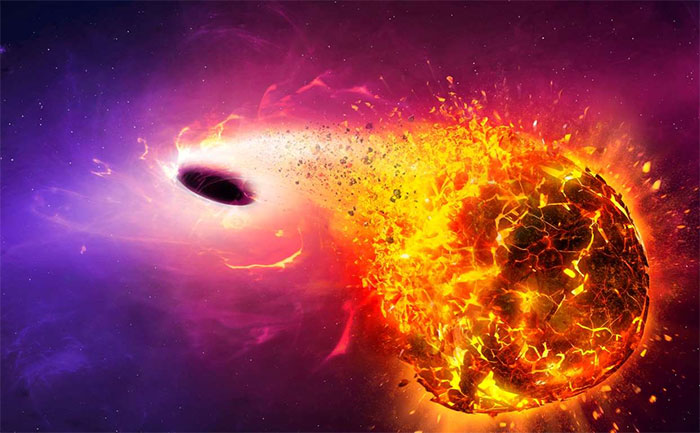Discover the mysterious 'food source', feeding on supermassive black holes for millions of years
Scientists have revealed what they believe to have 'fed' supermassive black holes in the early universe.
Astronomers have long wondered how these bizarre entities could grow so quickly just after the universe and galaxies formed hundreds of millions of years ago.
But now, by analyzing the core of more than two dozen galaxies that appeared about 12.5 billion years ago, it seems they have found the answer.

Artwork of a planet swallowed by a supermassive black hole
The researchers write in the Journal of Astrophysics that the 'food source' that supplies energy to early universes turns out to be huge clouds of hydrogen gas.
After surveying 31 quasars, they found that 12 of them were surrounded by dense, cool gas clouds forming the perfect food source for black holes.
Quasars are a collection of swirling matter thought to surround supermassive black holes at the centers of some galaxies. Although quasars can easily be detected due to their brightness, the hydrogen clouds surrounding their galaxies are harder to detect.
The scientists used Muse lenses mounted on a large telescope at the Southern European Observatory to make their observations.
Emanuele Paolo Farina, PhD at the Max Planck Astronomical Institute in Germany, said: 'The early presence of these monsters, with a mass several billion times the mass of our Sun, is still a large unknown numbers.
Now we can for the first time demonstrate that primitive galaxies have enough food in their environment to sustain both the growth of supermassive black holes and star formation.
It only takes a few hours for each target, we can go into the environment around the supermassive mass and the largest and 'voracious' in this young universe'.
Although quasars can glow, the clouds of gas surrounding them are much harder to see.
However, the Muse lens can detect the faint halos of these hydrogen clouds, allowing astronomers to finally reveal the ' food source' of supermassive black holes in the universe. the early period.
- Detected stunned the power of the supermassive black holes
- Millions of black holes are hiding in our galaxy
- The supermassive black hole closest to Earth glows intensely
- The supermassive black hole is 20 billion times more massive than the Sun
- The supermassive black hole 'carnivores' from the inside
- Three huge black holes are about to collide in the universe
- Discover hundreds of black holes in the universe
- The giant black hole in the Milky Way is just a mistake?
- The biggest black hole collision is 9 billion light-years away
- Discover the mystery of the most exotic black holes in the universe
- The moment the supermassive black hole swallowed
- Discover the largest pair of black holes near Earth
 Van Allen's belt and evidence that the Apollo 11 mission to the Moon was myth
Van Allen's belt and evidence that the Apollo 11 mission to the Moon was myth The levels of civilization in the universe (Kardashev scale)
The levels of civilization in the universe (Kardashev scale) Today Mars, the sun and the Earth are aligned
Today Mars, the sun and the Earth are aligned The Amazon owner announced a secret plan to build a space base for thousands of people
The Amazon owner announced a secret plan to build a space base for thousands of people